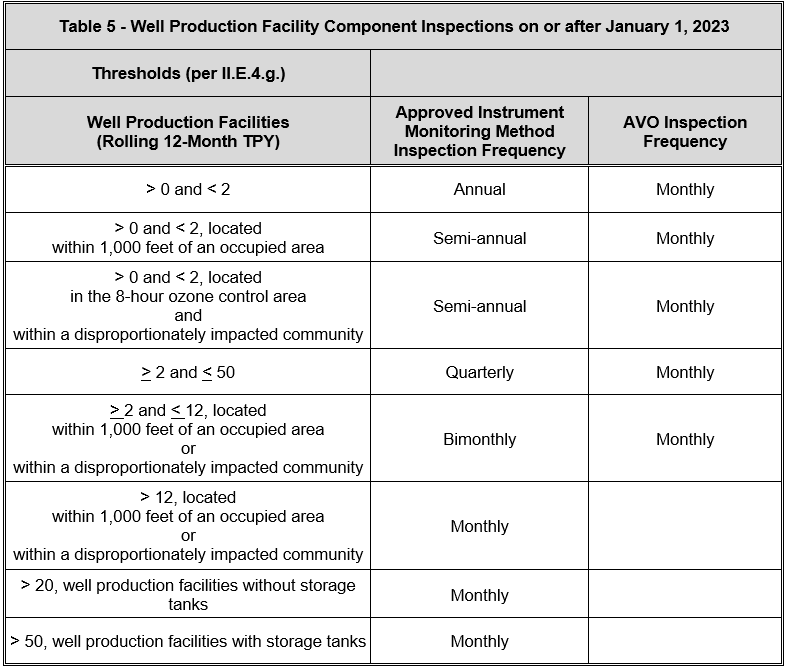- Facilities meeting certain design requirements listed under Section II.E.4.f. (e.g., when the operator installs and uses systems to continuously monitor and adjust the pressure in storage tanks to prevent venting, to continuously monitor pilot lights, or the operator constructs facilities that are tankless, without gas-fired engines, and without emitting pneumatic controllers) may be inspected less frequently.
Leak Repair Requirements (II.E.6-7)
- Beginning 2/14/2022, leaks found at well production facilities located within a DIC or at a facility meeting II.E.4.f. must either be repaired in accordance with the repair schedule in Section II.E.7.b (first attempt and repair within five [5] working days), or the leaks must be monitored using Method 21 within five (5) working days of leak detection. If monitoring shows a leak that must be repaired, then leaks between 500 parts per million (ppm) and 10,000 ppm must be repaired according to Section II.E.7.a, and leaks greater than or equal to 10,000 ppm must be repaired according to Section II.E.7.b.
- Beginning 2/14/2022, where technically feasible, emissions from leaks placed on delay of repair must be mitigated within no later than 48 hours of placing a leaking component on delay of repair.
Emissions from separators (II.F.)
On or after 2/14/2022, gas coming off a separator, produced during normal operation from any oil and gas well, must either be routed to a gas gathering line or controlled by air pollution control equipment that achieves a hydrocarbon control efficiency of 95%, unless emitting to the atmosphere is authorized pursuant to a variance issued by the Colorado Oil and Gas Conservation Commission.
Well maintenance, well liquids unloading events, and well plugging activities (II.G.)
Best Management Practices (II.G.1.c.)
Beginning 1/1/2023, the rule requires the use of prescriptive best management practices (BMPs) for all downhole well maintenance and well liquids unloading activities, as listed in II.G.1.c. Among other BMPs, the rule now requires new facilities (that commence operation after 1/1/2023) to be designed to minimize the need for well liquids unloading/maintenance with emissions to atmosphere. Additionally, operators must minimize emissions to the atmosphere from well liquids unloading and well swabbing through the installation, use, and optimization of artificial lift, such as plunger lift with smart automation (with some exceptions).
Capture and recovery or control of well liquids unloading/swabbing emissions (II.G.1.d.)
In addition to the BMPs above, beginning 1/1/2023, emissions during well liquids unloading and well swabbing operation must be captured and recovered or controlled if:
- The facility is located within a DIC and had more than or equal to six (6) well liquids unloading/swabbing with emissions to atmosphere during any rolling six-month period.
- The facility is not located within a DIC and had either (i) more than or equal to six (6) well liquids unloading/swabbing with emissions to atmosphere on a single well or (ii) more than or equal to ten (10) well liquids unloading/swabbing with emissions to atmosphere on all facility wells combined during any rolling six-month period.
- The counts of events above do not include well liquids unloading events caused by a nearby well fracking event provided that the Division is notified in writing within 48 hours, or as soon as possible if notice within 48 hours would require an alternative or extended well liquids unloading practice that increases emissions, prior to conducting the unloading (and the unloading activities are completed within 30 days of commencement of those activities).
- Capture or control of well unloading/swabbing emissions is not required if technically infeasible. The Division must approve any technical infeasibility determination.


